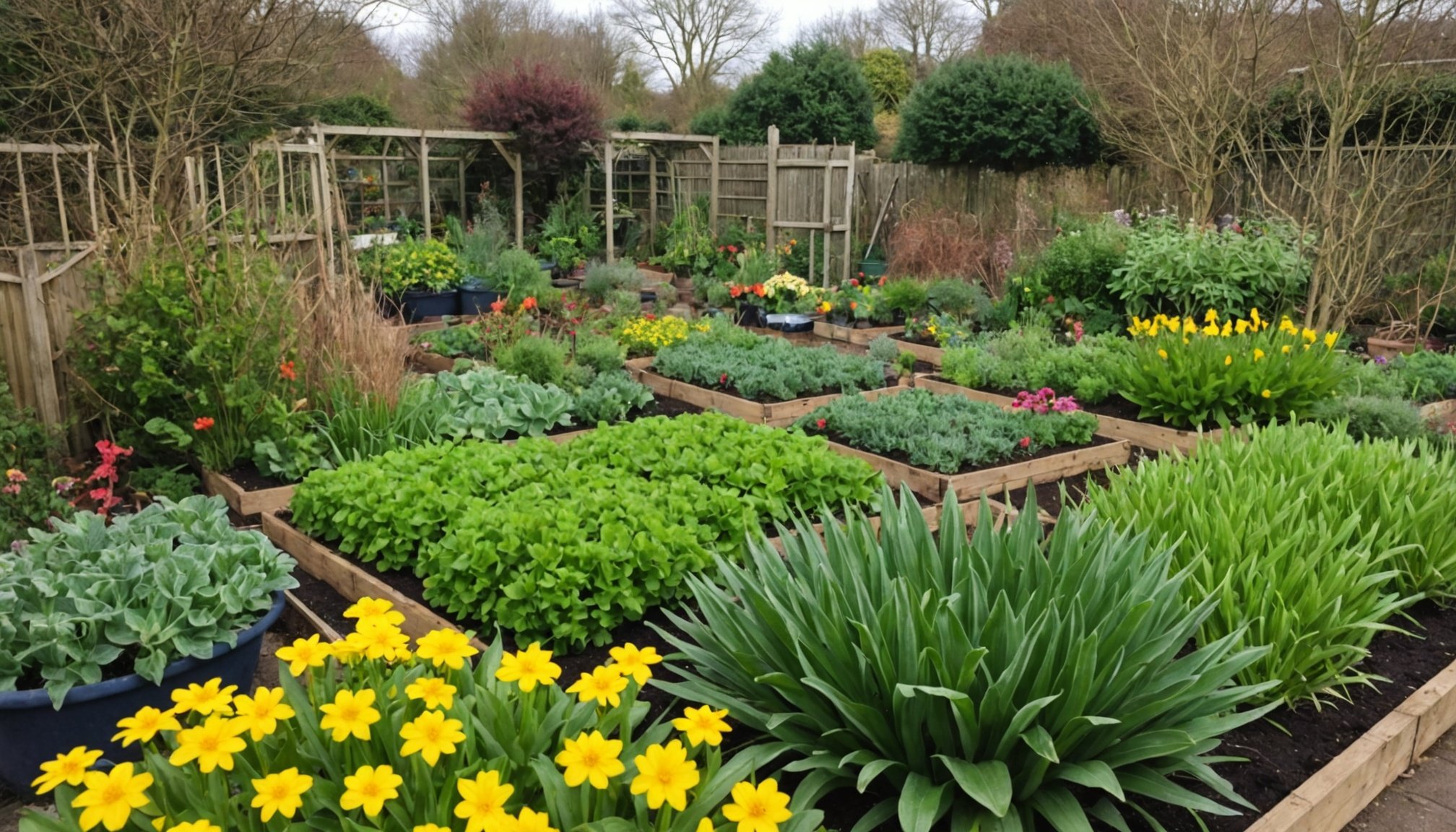Unlocking the Secrets to Thriving Winter Gardening in the UK’s Chilly Climate
As the UK’s winter months approach, many gardeners might think that their outdoor gardening activities need to come to a halt. However, with the right strategies and a bit of planning, you can enjoy a thriving garden even in the chilliest of climates. Here’s a comprehensive guide to help you make the most of your garden during the winter season.
Preparing Your Garden for Winter
Before the cold weather sets in, it’s crucial to prepare your garden to ensure it remains healthy and ready for the next growing season.
A voir aussi : Transform Your UK Urban Space: Harnessing Aquaponics for Thriving Vegetable Gardens
Clearing Out Old Plant Debris
The first step in preparing your garden for winter is to clear out old plant debris. This not only tidies up the space but also prevents diseases from overwintering in dead plant material. For disease-free plants, you can use the “chop and drop” method, where you cut the plant down at the base and lay the pieces on the soil to decompose over the winter, returning nutrients to the soil[1].
- Clear out dead plants and weeds to keep the soil clean and airy.
- Use the "chop and drop" method for composting in place.
- Remove any diseased plants entirely to prevent the spread of disease.
Protecting Plants from Frost
For plants that can withstand cooler temperatures, using frost covers can extend their growing season. Plants like those in the brassica family (such as kale and Brussels sprouts) can benefit from these covers, which act as a shield against harsh frost and preserve warmth around the plants[1].
A lire en complément : Transform Your UK Garden into a Pet Paradise: A Guide to Creating an Animal-Friendly Outdoor Space
- Use frost covers to protect cold-hardy plants.
- Wrap young trees or susceptible trees with burlap or tree wrap to prevent sunscald and frost cracks.
- Mulch perennials with materials like wood chips, pine needles, or straw to insulate their roots.
Preparing New Garden Beds
If you’re planning new garden beds for the next growing season, winter is an excellent time to start preparing the ground. Use the lasagna method by laying down untreated cardboard to smother weeds and grass, and top it with compost, leaves, or straw. This enriches the soil and creates a weed-free foundation for your future garden[1].
Growing Winter Vegetables
Winter doesn’t mean your vegetable garden has to be dormant. Here are some tips for growing winter vegetables and enjoying a fresh harvest even in the cold.
Why Grow Winter Vegetables?
Winter vegetables are hardier and often less susceptible to diseases and pests, which are less active in winter. These crops, such as kale and Brussels sprouts, contain extra nutrients in the colder months and require minimal maintenance[2].
- Winter vegetables thrive in low temperatures.
- They are less susceptible to diseases and pests.
- They contain extra nutrients and sugars due to the cold.
The Best Winter Vegetables for Your Garden
Not all vegetables can withstand the cold, but many varieties do well in winter. Popular choices include kale, Brussels sprouts, winter spinach, leeks, lamb’s lettuce, parsnips, and beetroot. These crops tolerate frost and add variety to your winter kitchen[2].
| Vegetable | Description | Sowing Time |
|---|---|---|
| Kale | A hardy green that gets sweeter after frost | Late summer/early autumn |
| Brussels Sprouts | A cold-hardy brassica that thrives in winter | Late summer/early autumn |
| Winter Spinach | A spinach variety that grows well in cold weather | October |
| Leeks | A root vegetable that can be harvested in winter | Late summer/early autumn |
| Lamb’s Lettuce | A cold-hardy leafy green that can be sown as late as October | October |
| Parsnips | A root vegetable that can be left in the ground over winter | Late summer/early autumn |
| Beetroot | A root vegetable that can tolerate light frosts | Late summer/early autumn |
Care and Protection for Winter Vegetables
Winter vegetables require little maintenance but some care to keep them healthy. Check regularly for dead leaves and remove them to prevent mold. Water less frequently but ensure the soil doesn’t dry out completely. During prolonged frost, a layer of straw around the plants can provide extra insulation[2].
- Check for dead leaves and remove them to prevent mold.
- Water less frequently but keep the soil from drying out.
- Use straw or fleece covers for extra insulation during prolonged frost.
Creating a Winter Container Garden
If you don’t have garden space or want to add some winter charm to your outdoor areas, creating a winter container garden is a great way to do so.
Assembling the Materials
Gather your supplies, including branches, boughs, and accessories. Consider using materials from your own garden or local nurseries. Cedar, juniper, and pine boughs are great for adding greenery, while sticks and other natural elements can add height and interest[3].
- Gather branches, boughs, and other natural materials.
- Use materials from your garden or local nurseries.
- Add accessories like ribbon, twinkle lights, and ornaments.
Putting it All Together
Arrange your materials in a way that looks appealing to you. Use the “thrillers, fillers, and spillers” concept to create a balanced and visually appealing arrangement. Take a step back and make adjustments as necessary to ensure your container garden looks great from all angles[3].
- Arrange materials using the "thrillers, fillers, and spillers" concept.
- Add ribbon and other accessories to enhance the design.
- Make adjustments to ensure a balanced and appealing arrangement.
Taking Hardwood Cuttings for Next Year’s Garden
One of the most effective ways to prepare for the next growing season is by taking hardwood cuttings in the winter.
Why Take Hardwood Cuttings in November?
According to Monty Don, taking hardwood cuttings in November is a straightforward way to create new shrubs, bushes, and trees from existing favorites. This method ensures that the new plants are exactly like the parent plant and requires minimal equipment or shelter[4].
- Take hardwood cuttings from fruit bushes, roses, and flowering shrubs.
- Cut a 12-24 inch length of straight stem, the thickness of a pencil.
- Divide the stem into lengths between 6 and 12 inches long.
The Process of Taking Hardwood Cuttings
Cut straight across the bottom and at an angle at the top of the stem to help remember which way up to plant it. Strip any remaining leaves from the stem and plant it in a deep pot filled with gritty compost or outside in a narrow trench backfilled with gritty sand. Water once a week and let the cuttings undergo a period of callusing over the winter, from which roots will develop in the spring[4].
Additional Tips for Winter Gardening
Here are some additional tips to help you make the most of your garden during the winter months.
Mulching and Protecting Plants
Mulching is a great way to protect plants from extreme temperatures. Use a thick layer of mulch such as wood chips, pine needles, or straw around perennial plants to insulate their roots and retain moisture. For delicate plants, use frost blankets or cloth to protect them from cold snaps[1][5].
- Mulch perennials with materials like wood chips, pine needles, or straw.
- Use frost blankets or cloth to protect delicate plants.
- Ensure good drainage to prevent waterlogged soil.
Assessing and Maintaining Structures
Winter can be brutal on garden structures, so it’s important to assess and maintain them. Drain and shut down irrigation systems to prevent freezing, check greenhouses for cracks or leaks, and ensure heaters and fans are functioning properly. Also, keep walkways and customer areas clear of ice and snow[5].
- Drain and shut down irrigation systems.
- Check greenhouses for cracks or leaks.
- Ensure heaters and fans are functioning properly.
- Keep walkways and customer areas clear of ice and snow.
Winter gardening in the UK’s chilly climate is not just possible but also rewarding. By clearing out old plant debris, protecting your plants from frost, growing winter vegetables, creating a winter container garden, and taking hardwood cuttings, you can ensure your garden remains vibrant and healthy throughout the year.
As Monty Don advises, “Taking hardwood cuttings is a remarkably straightforward way of creating new shrubs, bushes and even trees from existing favourites.” This, along with other winter gardening tips, will give you a head start on the next growing season and allow you to enjoy fresh, healthy produce year-round.
So, don’t let the cold weather deter you from gardening. With a little planning and the right techniques, you can unlock the secrets to thriving winter gardening and make the most of your garden, even in the chilliest of climates.












